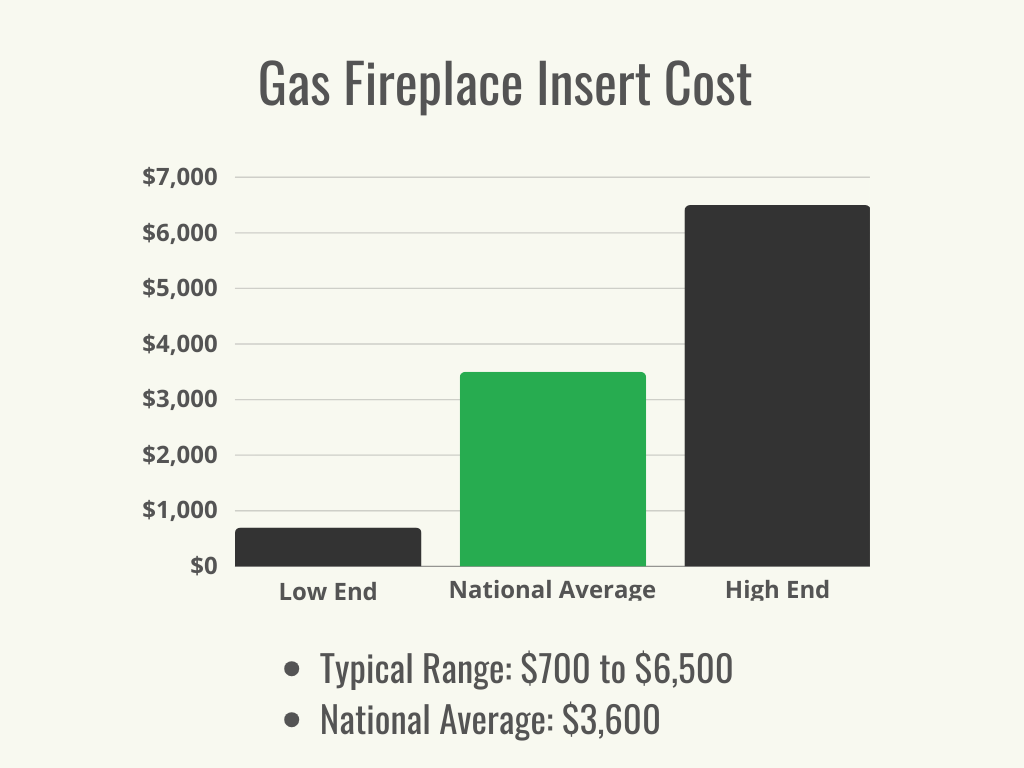We may earn revenue from the products available on this page and participate in affiliate programs. Learn More ›
Highlights
- The typical range for installing a gas fireplace insert is $700 to $6,500 with a national average of $3,600.
- Cost factors for installing a gas fireplace insert include the insert size, labor and installation, whether the fireplace is vented or unvented, and running costs.
- Some of the benefits of a gas fireplace insert are the ability to use an existing wood-burning fireplace, cost efficiency, convenience, improved aesthetics, environmental friendliness, minimal maintenance, lack of ash and creosote, and safety.
- Installing a gas fireplace insert is best left to a professional as working with gas lines without experience can be highly dangerous.
A gas fireplace insert provides the glow and warmth of a fire that many homeowners desire without the inconvenience and expense of burning wood. For those who have an existing wood-burning fireplace, a gas fireplace insert can transform it into a gas-powered centerpiece of the home. According to Angi, gas fireplace insert costs range from $700 to $6,500, with an average cost of $3,600. This cost range applies if the existing duct and chimney system are in good condition. These inserts are more cost-effective than a wood-burning fireplace, and many homeowners choose gas fireplace inserts to update and modernize their existing fireplaces.
What is a gas fireplace insert?
A gas fireplace insert is a metal box within a metal box that fits inside an existing fireplace and blocks the draft from the chimney. The gas insert heats the air between the two metal boxes, and then that heat is released into the room. This is an excellent option for homeowners who want to rework their existing wood-burning fireplace into a fuel-efficient heat source. A gas fireplace insert is a good option for homeowners who are interested in zone heating their home and assisting the HVAC system so it doesn’t run as much during the colder winter months.
Gas fireplace inserts burn more efficiently than their wood-burning counterparts. A gas insert produces fewer emissions and releases fewer fine particulates into the air, which is helpful for those who suffer from allergies and respiratory illnesses. A fireplace insert often includes circulating fans that push the heat into the room, reducing the amount of heated air from escaping up the chimney.
Gas Fireplace vs. Gas Fireplace Insert
Gas fireplaces are built into a wall of a home during construction or a major renovation. The big difference between a gas fireplace and a gas fireplace insert is that the gas fireplace doesn’t need an existing fireplace or even a chimney. If the home doesn’t have an existing fireplace and chimney, a gas fireplace can be installed so it vents out through a wall, or another option is an unvented gas fireplace. With an unvented gas fireplace, the exhaust is released back into the room. A gas fireplace’s BTUs (British thermal unit) are higher than those of a gas fireplace insert, so more heat will come from the built-in gas fireplace.
Factors in Calculating Gas Fireplace Insert Cost
Several factors impact the cost of gas fireplace inserts. Prices can differ from the national average due to labor and installation fees, the price of the gas fireplace insert, and whether the insert is vented or unvented.
Insert Size
Different sizes of gas fireplace inserts exist for various fireplace and room sizes. It takes an insert of about 36 inches to heat a 2,000-square-foot area. This size insert costs about $2,000. On the other hand, a smaller room of about 100 square feet takes an 18-inch insert, which costs $500 on average.
Labor and Installation
Labor and materials to install a gas fireplace insert can run from $500 to $1,500, which is significantly less than it would cost to install a new fireplace. By using the existing fireplace, labor costs are reduced for the project. Other factors that can affect labor costs are whether a new gas line or electrical wiring needs to be installed. If extra gas lines are required or additional ductwork is necessary, costs could increase by as much as $6,000.
Vented vs. Unvented
Gas fireplace inserts are available in vented or unvented options. Direct-vent units are considered the safest choice. They exhaust all the gases and water vapor produced from burning gas and vent it to the outside while pulling in the outside air to keep the flames alight. Vented inserts generally have a realistic fireplace aesthetic because the temperature is controlled. This results in a flame pattern and color that mimics a wood-burning fire. Direct-vent models cost about $4,300 to $11,200.
Unvented units have a higher efficiency rating since a large percentage of the heat goes into the room and not up the chimney. They’re easy to install, but they lower the amount of oxygen in the space since there isn’t any outside air coming in to feed the flames. The exhaust gas and moisture from the burning gas stay in the room, which can cause concern for some homeowners. If left unchecked, the higher humidity levels can cause condensation and generate mold and mildew as well as issues with wooden furniture and flooring. Many unvented gas fireplace inserts come with an oxygen sensor that will turn off the gas before carbon monoxide reaches unsafe levels. Some states have outlawed unvented gas fireplace inserts, so it’s a good idea to check with a fireplace insert professional. On average, unvented units cost $1,500 to $4,600.
Running Costs
Gas fireplaces are generally considered to be one of the cheapest heating methods in terms of operating costs. The U.S. Energy Information Administration reported that average household gas costs were around $500 for the winters of 2020 and 2021, which is less than half of what homeowners paid for propane.
Additional Costs and Considerations
When budgeting for gas fireplace insert costs, it’s helpful to know any additional price factors and considerations that can affect the total cost. These can include extra gas plumbing, electrical wiring, surround material, maintenance, and unit repair.
Gas or Electrical Line Installation
Securing the gas line to the gas fireplace insert or installing extra gas lines can cost about $25 per linear foot. In some areas of the country, a permit is required to run or modify gas lines. It’s a good idea to check the local requirements to know if permit fees will need to be included in the budget.
Surround Material
A large part of fireplace remodel costs depends on the homeowner’s choice of surround material. This is the material that is used around the fireplace, which can add to or detract from the room’s overall character. Some of the most common materials are brick, tile, and stone, which can create a modern, rustic, or eclectic appearance in the room. For those interested in fireplace refacing, some material options for surrounds include tiles, metal, brick, wood, stone, marble, and masonry. These can cost an additional $9 to $300 per square foot.
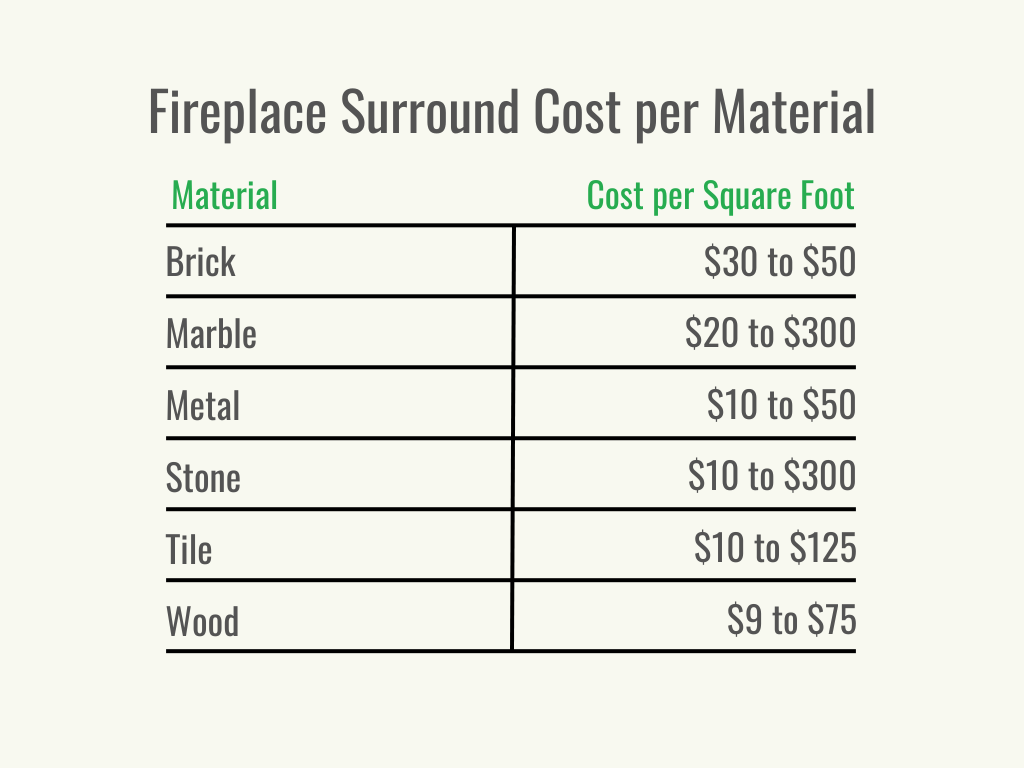
Maintenance and Repair
One of the advantages of gas fireplace inserts is that they require little maintenance aside from an annual checkup that costs between $75 and $125. If the gas fireplace insert uses a chimney for venting purposes, a yearly chimney inspection costs about $450 on average. If any damage is discovered during the inspection, chimney repair costs may also apply. It’s essential to follow a regular maintenance schedule to ensure the gas insert works correctly and safely. Gas fireplace inserts need different repairs than a wood-burning or electric fireplace would need. If the fireplace insert breaks or malfunctions, a professional who repairs gas fireplaces will typically charge $200 and $1,000 to fix it.
Types of Gas Fireplace Inserts
Natural gas fireplace inserts come in a variety of unit types and models to accommodate various spaces. On the low end of the cost spectrum, a tabletop fireplace costs an average of $250. On the higher end, island fireplaces can cost as much as $13,500. The best gas fireplace insert type for a particular home may depend on the cost, size, and style.
| Insert Type | Average Cost (Materials and Labor) |
| Corner | $2,000 to $11,000 |
| Freestanding | $1,700 to $6,800 |
| Gas log | $1,800 to $7,200 |
| Island | $2,700 to $13,500 |
| Peninsula | $4,700 to $12,000 |
| Tabletop | $100 to $400 |
| Wall-mounted | $1,300 to $4,100 |
Corner
Corner fireplaces are popular for relatively small rooms that don’t have an existing fireplace. Prefabricated corner fireplaces cost about $2,000 to $5,500 after installation, but custom units can reach as much as $11,000. Corner units also require a gas line, which will come with an additional cost.
Freestanding
Resembling classic pellet stoves, freestanding gas fireplace inserts can be installed anywhere in the home where gas lines can be connected. The average cost range for these units is between $1,700 and $6,800.
Gas Log
Gas log fireplaces feature an artificial wood log made of ceramic to provide the look of a real fireplace. Some units also include steam, flames, and lights for additional effect. Gas log fireplace inserts cost about $1,800 to $7,200. Alternatively, an existing fireplace can be fitted with a gas log for about $800.
Island
Island fireplaces are typically four-sided and can be installed in the middle of the room or to separate two adjacent spaces. This can be useful in homes that don’t have an existing cavity for a fireplace. Depending on the size and whether the unit is custom-made, island fireplace inserts can cost $2,700 to $13,500.
Peninsula
Peninsula fireplaces can be added to a feature wall that separates two rooms. They can be two- or three-sided depending on the placement of the wall. Homeowners can expect to pay between $4,700 to $6,800 for a prefab unit or $7,000 to $12,000 for a custom one.
Tabletop
Tabletop gas fireplaces are a great option for homeowners whose space or budget are limited. These small units cost between $100 and $400, with an average of $250. They are popular for outdoor heating and lighting as they only require a small branch gas hookup and do not emit smoke.
Wall-Mounted
Wall-mounted fireplace inserts are another space-saving option that requires almost no framing. They can be hung on the wall or built into it, meaning they do not take up any floor space. Wall-mounted fireplaces cost about $1,300 to $4,100 installed.
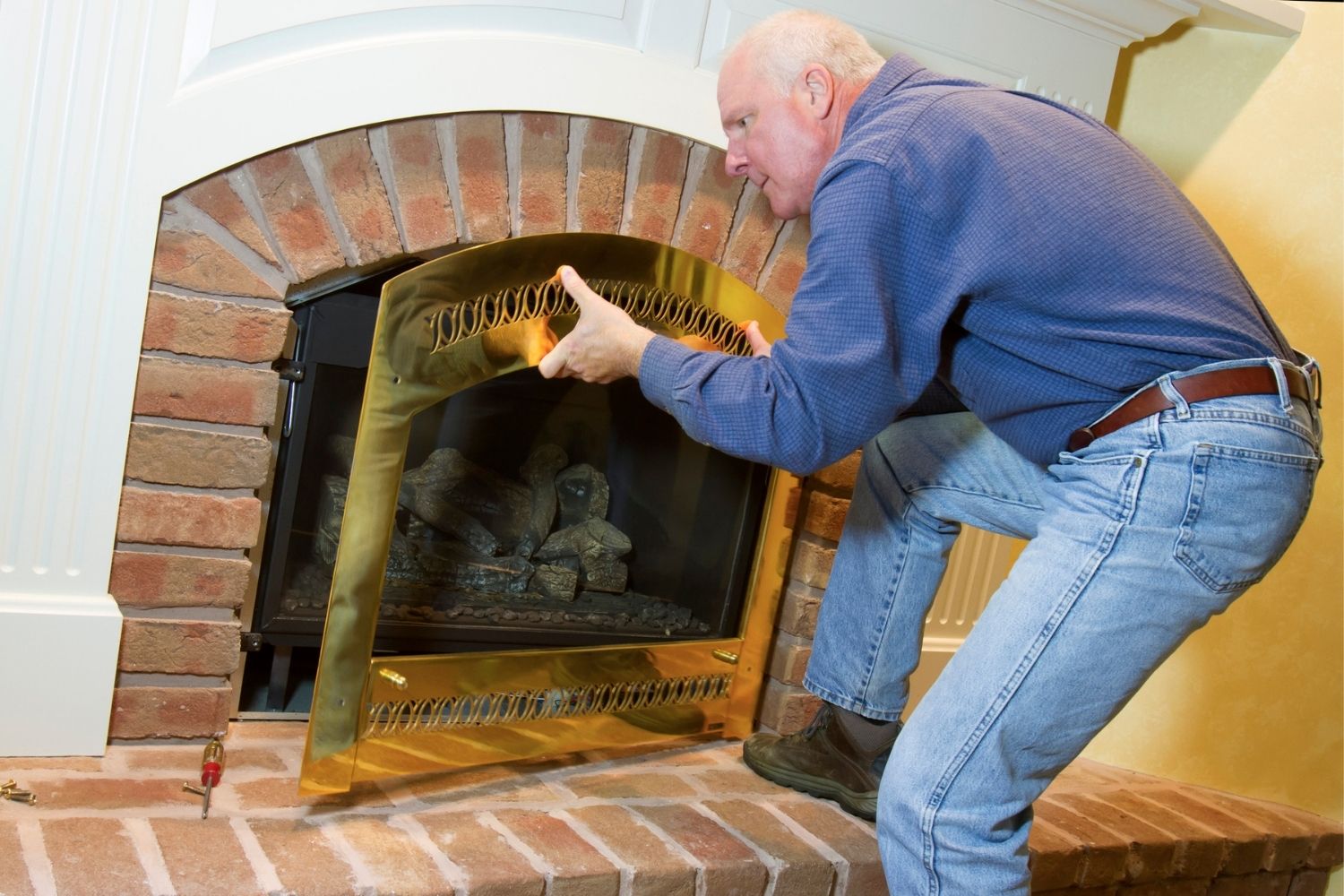
Benefits of Choosing a Gas Fireplace Insert
Gas fireplace inserts are a cost-effective and straightforward way to transform a wood-burning fireplace into a gas-burning one. A gas fireplace insert can be used as a heat source to increase the effectiveness of a home’s HVAC system. Many homeowners enjoy the look of real flames without the hassle of moving and stacking firewood or cleaning out a fireplace full of ash.
Use of an Existing Wood-Burning Fireplace
Gas fireplace inserts can be used in an existing wood-burning fireplace to make it more efficient or bring it into compliance with current building codes. The insert is smaller than the fireplace opening, and it can be vented using the chimney that’s already in place.
Cost-Efficiency
A gas fireplace insert is less expensive to install than a gas fireplace. The cost of running a gas insert per hour is at least 50 percent lower than a wood-burning or propane-burning fireplace. A traditional wood-burning fireplace is also typically drafty and allows a lot of heated air to escape up the chimney. A gas fireplace insert seals off the drafty fireplace and releases all the heat into the room, saving on utility costs.
Convenience
With a gas fireplace insert, homeowners can enjoy the heat, glow, and look of a fire with the flip of a switch, without the smoke and odor of a wood-burning fire. Gas inserts typically come with a thermostat so it’s possible to enjoy the heat with precision control.
Aesthetics
A gas fireplace insert is an attractive way to heat a room. Many modern gas fireplace inserts have a sleek design that can elevate the look of a space. Whichever style a homeowner chooses, the ambience of the home will be enhanced by the warm glow of a fire that ignites with a flip of a switch.
Environmentally Friendly
A wood-burning fireplace releases up to 4,000 percent more emissions than a gas-fueled insert. A gas-powered insert has a high energy rating and does not create waste in the form of ash, soot, and creosote—and that’s good for the environment.
Minimal Maintenance
Maintenance is at a minimum for a gas fireplace insert since there are no ashes to clean out of the fireplace. They also require less frequent repairs than electric fireplace inserts. Having a gas insert involves an annual checkup to inspect the venting, fan, burner, thermostat, pilot light, and glass.
No Ash or Creosote Production
Gas fireplace inserts are a good option for those who are sensitive to air pollution or have allergies or other lung diseases. A wood-burning fireplace insert releases fine particulates into the air that can create health issues and respiratory problems. A gas fireplace insert will eliminate those issues since there is no ash or creosote formed by gas burning. An insert is also a cleaner option since there is no ash or soot to clean out of the fireplace.
Few Safety Concerns
A gas fireplace insert is a safe choice since it can be directly vented outside. If using an unvented insert option, these models come with an oxygen depletion sensor and a safety valve that will turn off the gas before carbon monoxide levels become dangerous in the room.
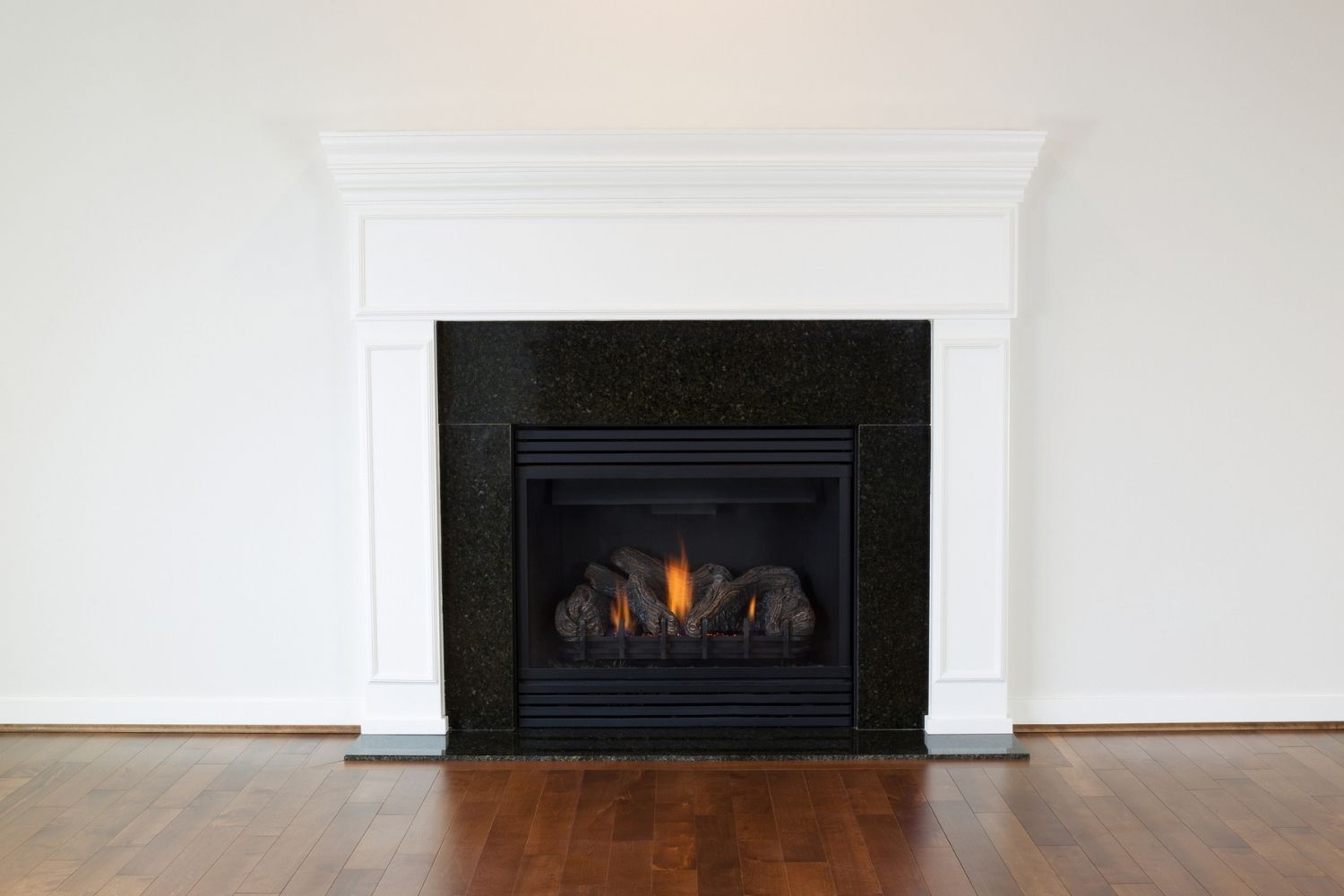
Gas Fireplace Insert Installation: DIY vs. Hiring a Professional
It’s not recommended to install a gas fireplace insert as a DIY project. Since installing a gas fireplace insert involves working with gas lines, electrical wiring, vent pipes, and potentially the roof, hiring a professional is recommended. A professional will have the experience and knowledge base to install the gas insert correctly and safely. Some areas of the country require a permit when installing a gas fireplace insert and adding or extending gas lines. After the installation, an inspection is needed to ensure the project meets the local building codes and standards. A professional contractor can handle the permits and the installation.
How to Save Money on a Gas Fireplace Insert Cost
Gas fireplace insert costs can be high, and the additional costs associated with the project can quickly add up. One way to save on gas fireplace insert costs is to buy the cheapest option, but there are other ways to save without compromising quality.
- Get multiple estimates. Get at least three estimates from reputable gas fireplace contractors in your area, and choose the one that works the best for you and your budget.
- Do some of the prep yourself. Prepping and cleaning the area before the professional installers arrive is one way to save on labor costs. The same goes for adding some finishing touches after the installation.
- Hire professionals. It may seem tempting to save money by installing a gas fireplace insert on your own. The added cost of fixing mistakes, the energy loss due to an incorrect installation, and the safety risks to you and your family aren’t worth it.
- Get references. Talk to others who have had a gas fireplace insert installed in their home and ask about their experiences. They can add valuable insight and inform you about the workmanship of the company they used. The cheapest contractor isn’t always the answer since you may pay extra for needed repairs down the road if the job isn’t done right.
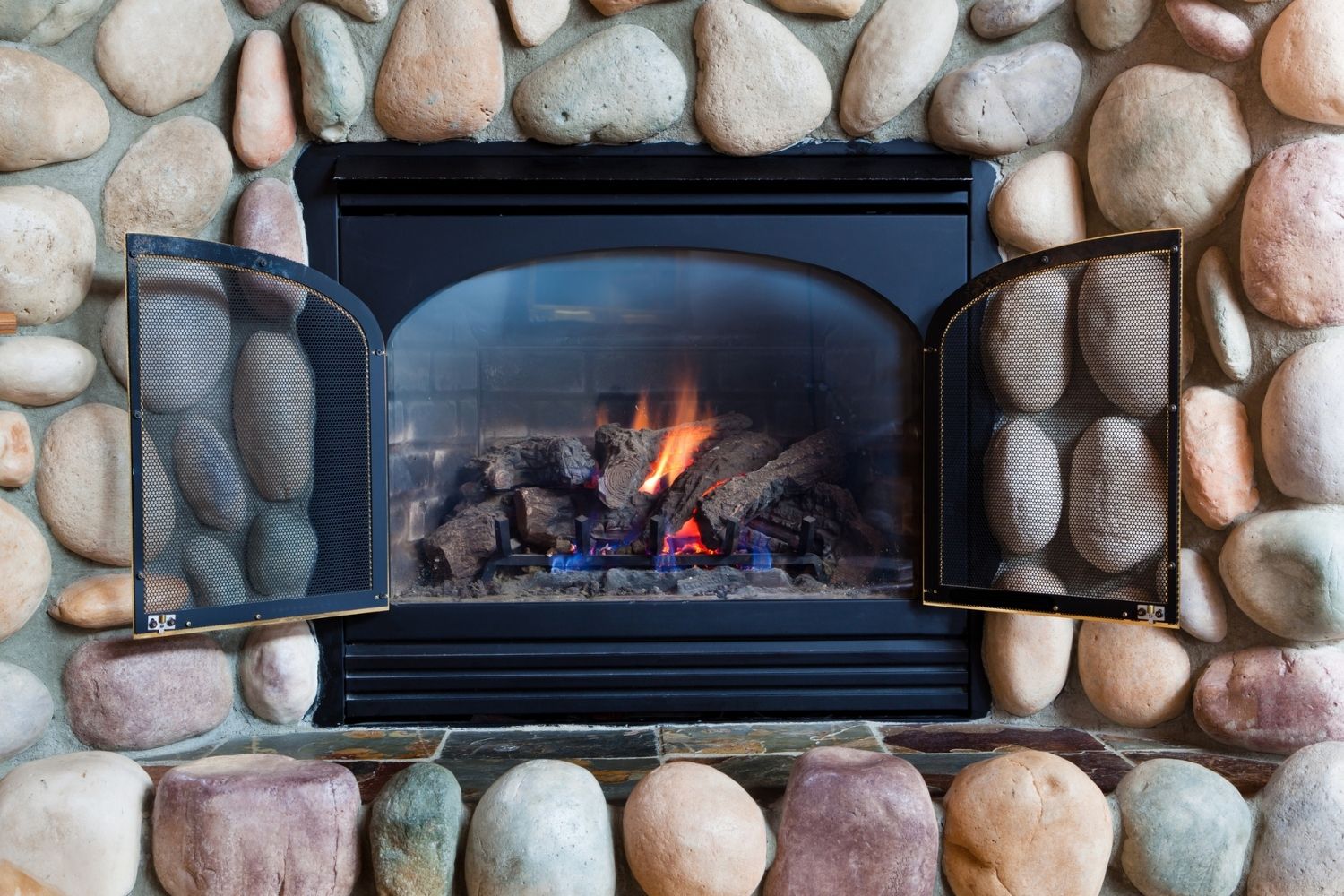
Questions to Ask About Gas Fireplace Insert Installation
Asking a professional the right questions about gas fireplace insert costs can minimize miscommunication, save money, and get the desired results. Here are some questions to ask a gas fireplace insert installation professional.
- Are you licensed and insured? (Some locations may require contractors to be licensed and insured, while others may not. Check with your municipality.)
- Do you have references?
- Are you NFI (National Fireplace Institute) certified?
- How much experience do you have installing this type of gas fireplace insert?
- Do you offer free estimates?
- Who will install the gas fireplace insert?
- How long will the installation take?
- Do I need to have additional gas line work or extensions done?
- Is additional electrical wiring needed?
- Is the vent powerful enough to release exhaust?
- What kind of warranty do you offer?
FAQs
Deciding on a gas fireplace insert while staying within budget can be a daunting process. Here are some frequently asked questions about gas fireplace insert cost to help guide the decision-making process.
Q. How much propane does a propane gas fireplace insert use?
A propane gas fireplace insert uses approximately 1 gallon of propane per 100,000 BTUs (British thermal unit). Modern propane fireplace inserts have efficiencies of roughly 80 percent.
Q. When should I replace my fireplace insert?
A gas fireplace insert should be replaced if you’ve purchased a new home and the fireplace insert is old, not working properly, or doesn’t match your personal style. It should also be replaced if you’re remodeling your home and changing the function of the rooms, the gas fireplace isn’t turning on consistently, it’s not working as efficiently as it should, it needs constant repair, you want to replace the surrounding facing material, or you want the most updated gas fireplace insert in your home.
Sources: Angi, HomeAdvisor

